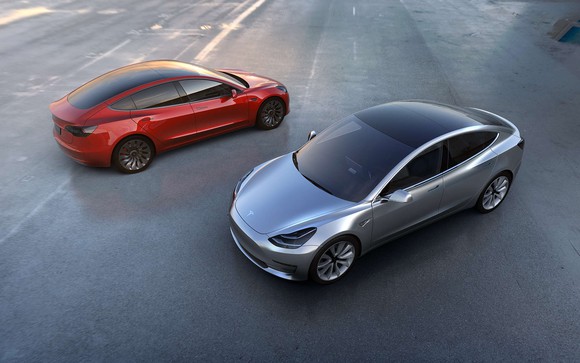Last Tuesday, Tesla (TSLA 4.62%) published its highly anticipated first quarter production update. While the company fell short of its Model 3 production goal, management touted Tesla's 40% increase in production relative to the prior quarter.
Investors seemed satisfied as well. Indeed, Tesla stock rallied more than 20% in the three days following the update, recovering its steep losses from the previous week. Nevertheless, some of the details from the production report aren't nearly as positive for Tesla as Elon Musk and his management team want investors to think.
Clear signs of manipulation
In the production update, Tesla declared that it had produced 2,020 Model 3 sedans in the past seven days. This didn't quite reach the 2,500 vehicles/week target that had been confirmed as recently as early February. Yet it still marked a big increase relative to late 2017, drawing effusive praise from management.

Tesla recently built more than 2,000 Model 3s in a single week. Image source: Tesla.
However, while Tesla may have produced 2,020 vehicles in the seven days ending on April 2, its current sustainable production rate for the Model 3 is lower than that. Tesla transferred workers from Model S and Model X production to the Model 3 for at least one or two days at the end of March to boost output. It also appears to have run its factory more than the standard two shifts, which means it probably incurred substantial overtime costs.
Artificially boosting production at the end of the quarter is nothing new for Tesla. For example, Tesla built 793 Model 3's in the last seven working days of Q4. Had it sustained that rate for a full quarter, it would have produced more than 10,000 units last quarter. Furthermore, it claimed to have reached a Model 3 production rate of more than 1,000 vehicles/week by early 2018.
Instead, Model 3 production totaled 9,766 units last quarter. Excluding the surge in the last week of the quarter, Model 3 output appears to have averaged fewer than 700 units/week -- well below the production rate supposedly achieved by the beginning of the period.
Thus, even if Tesla gets close to its target of building 5,000 Model 3's per week by the end of June, that's likely to represent a single week of running flat-out to maximize output. It could take several more months for Tesla to reach a sustainable 5,000/week production rate.
How safe is the order backlog?
Tesla also noted that the Model 3 reservation total remained roughly stable last quarter. "The reasons for order cancellation are almost entirely due to delays in production in general and delays in availability of certain planned options, particularly dual motor AWD and the smaller battery pack," according to the company.

After an initial burst of preorders, the number of Model 3 reservations has stagnated. Image source: Tesla.
This statement was presumably meant to reassure investors. However, it's not necessarily good news for Tesla's plan to boost production to 10,000 vehicles/week.
Ever since Tesla received more than 325,000 Model 3 reservations in the first week of preorders, most investors have assumed that supply is the only real challenge to reaching annual production of 500,000 units or more. Yet that may not be true.
If customers aren't willing to "wait out" production delays, it may reflect diminished brand appeal for Tesla. After all, customers who put down deposits during the first week of preorders knew that they were in for a long wait: at least a year or two.
Additionally, if some customers are canceling their reservations due to delays in the availability of some Model 3 versions, it may indicate that price-sensitive customers are starting to give up. In theory, the Model 3 has a starting price of $35,000. But it's very affordable after the $7,500 federal tax credit that is currently available. (Some states offer additional incentives.)
However, the federal tax credit will start to phase out soon. It will likely fall to $3,750 by the beginning of 2019 and disappear entirely by the beginning of 2020.
For the moment, Tesla is only selling a $50,000 premium version of the Model 3. Thus, reservation holders must choose between paying $42,500 after the federal tax credit for a fully loaded Model 3 now or waiting and potentially paying $35,000 (with no federal tax credit) for a bare-bones version. Price-sensitive consumers may not be happy with either option.
A bunch of reservations could melt away in the next year
As the Model 3 production rate accelerates over the next few quarters, reservation cancellations are likely to accelerate as well. After all, with each passing quarter, more and more reservation holders will have to decide whether to take a refund of their $1,000 deposit or confirm their order and pay the rest of the cost.
Furthermore, with Model 3 production running behind Tesla's targets, only a fraction of current U.S. reservation holders will be eligible for the full $7,500 federal tax credit. As customers discover that they won't get their vehicles by the end of 2018, there could be another wave of cancellations.
In the grand scheme of things, Tesla's accomplishments over the past five years have been very impressive. However, compared to its $50 billion-plus valuation, Tesla still has a lot to prove. Boosting Model 3 production to a sustainable rate of at least 5,000 units/week and getting the Model 3 reservation total growing again would go a long way in that respect.
